What Is the Easiest Fruit Tree to Keep Alive on a Balcony?
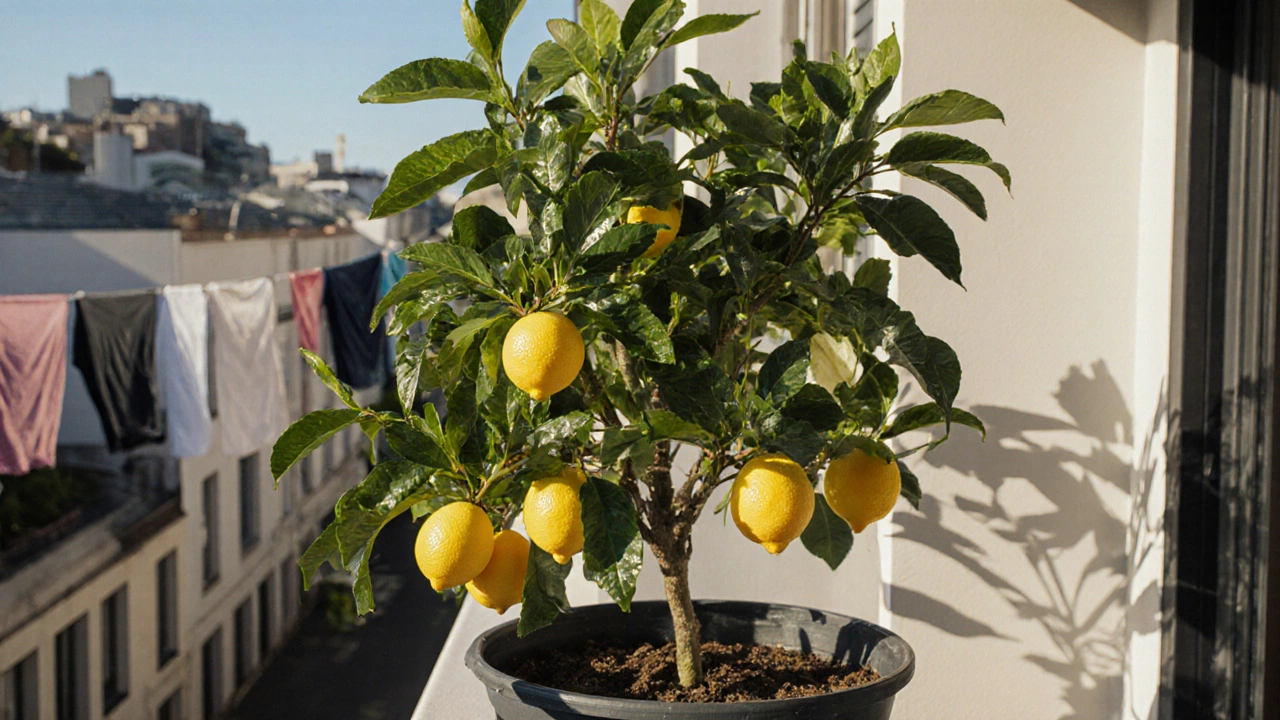
What Is the Easiest Fruit Tree to Keep Alive on a Balcony?
Balcony Fruit Tree Estimator
Estimate Your Harvest
Find out how many lemons your balcony could produce
How It Works
Your lemon tree's yield depends on two key factors:
More sun = more flowers = more fruit. 4 hours = survival minimum, 6+ hours = optimal yield.
Larger pots hold more soil moisture and nutrients. 40L is minimum for healthy growth.
Your Estimated Harvest
How to maximize your yield: Water when soil feels dry, fertilize every 6-8 weeks with citrus-specific food, and avoid over-pruning.
If you’ve ever tried growing a fruit tree on your balcony and watched it wither in a few weeks, you’re not alone. Most people assume fruit trees need acres of land, perfect soil, and hours of care. But that’s not true-especially not in cities like Auckland, where balconies are the new backyards. The truth is, some fruit trees are so tough they’ll thrive even if you forget to water them for a week. And yes, you can grow them in a pot smaller than your laundry basket.
The Winner: Dwarf Lemon Trees
The easiest fruit tree to keep alive on a balcony is the dwarf lemon tree. Not because it’s fancy. Not because it looks Instagram-ready. But because it’s stubborn. It doesn’t need perfect conditions. It doesn’t demand attention. It just keeps going.
Dwarf lemon trees, like the Improved Meyer Lemon, grow to about 2-3 meters tall-even in a 40-liter pot. They flower in spring, produce fruit by late summer, and keep blooming off and on all year. In Auckland’s mild winters, they stay green and active. Even if you leave them dry for ten days, they’ll bounce back. Most other fruit trees? They drop leaves, go dormant, or die.
Real talk: I’ve seen people grow Meyer lemons on 8th-floor balconies with no direct sun. They got just four hours of afternoon light. They still produced 10-15 lemons a year. That’s more than enough for homemade lemonade, salad dressings, or just the satisfaction of picking your own fruit.
Why Other Fruit Trees Struggle on Balconies
Apples? Too big. Even dwarf varieties need 3-4 meters of space and deep soil. They also need a cold winter chill to set fruit-something most Auckland balconies don’t deliver. Pears? Same problem. They’re slow growers and picky about pollination.
Stone fruits like peaches and nectarines? They need full sun, constant pruning, and regular spraying to fight pests. One fungal infection and your whole tree’s gone. And don’t even think about figs unless you’re ready to repot every year. They get root-bound fast and start dropping leaves like confetti.
Blueberries? They sound easy, but they need acidic soil (pH 4.5-5.5), special potting mix, and regular feeding with iron chelates. Most people buy them, water them with tap water (which is alkaline), and wonder why the leaves turn yellow.
Dwarf citrus, on the other hand, works with regular potting mix. It doesn’t need special pH. It doesn’t need spray bottles. It just needs a sunny spot and water when the soil feels dry.
How to Plant and Care for a Dwarf Lemon Tree
Here’s how to get started-no gardening degree required.
- Get a pot that’s at least 40 liters (about 10 gallons). Bigger is better, but 40 liters is the minimum. Make sure it has drainage holes.
- Use standard potting mix-not garden soil. Garden soil compacts in pots and kills roots.
- Plant the tree so the soil line matches the level it was in the nursery pot. Don’t bury the trunk.
- Place it where it gets at least 4-6 hours of direct sun daily. A west- or south-facing balcony works best in the Southern Hemisphere.
- Water when the top 3 cm of soil feels dry. Stick your finger in. If it’s damp, wait. If it’s dusty, water deeply until it runs out the bottom.
- Fertilize every 6-8 weeks from spring to autumn with a citrus-specific fertilizer. Look for one with extra magnesium and iron. Avoid overfeeding. More is not better.
- Prune only to remove dead wood or branches that rub against the railing. Don’t shape it like a topiary. Citrus trees fruit on new growth. Cut too much, you cut your harvest.
That’s it. No mulching. No staking. No special humidity tricks. Just water, sun, and food when it’s hungry.
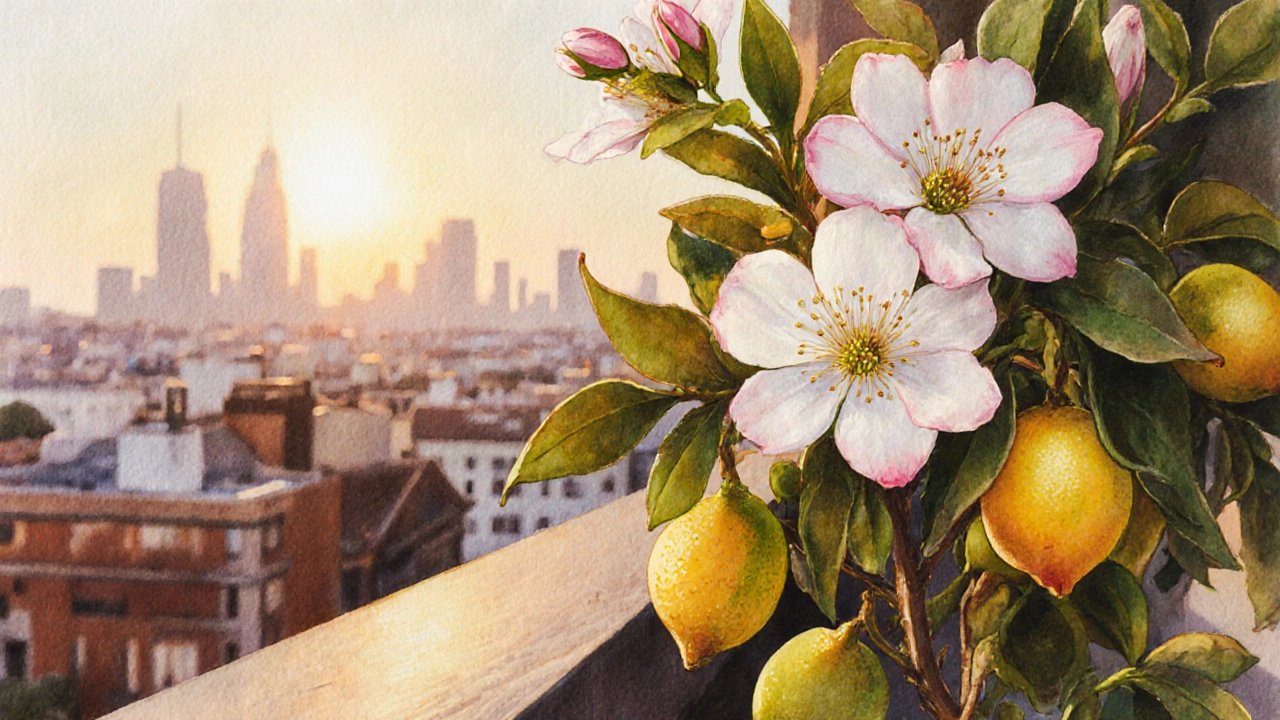
What to Expect in the First Year
Don’t expect a harvest in year one. Most dwarf lemon trees take 1-2 years to settle in. In year one, you’ll see new leaves, maybe a few flowers, and possibly one or two small fruits. Let those early fruits drop. The tree needs to focus on roots, not fruit.
By year two, you’ll likely get 5-10 lemons. By year three? 15-30. And they’ll keep getting better. The fruit gets sweeter as the tree matures. Some people say their Meyer lemons taste like a cross between a lemon and an orange. That’s because they are-a hybrid of lemon and orange.
Common Mistakes (and How to Avoid Them)
People mess up dwarf lemon trees in the same few ways, over and over.
- Using the wrong pot: Plastic pots crack in sun. Terracotta dries out too fast. Go for thick, UV-resistant plastic or fiberglass. Light color = cooler roots.
- Watering too much: Root rot kills more citrus trees than drought. If the pot feels heavy and the leaves are yellowing, you’re overwatering.
- Keeping it in the shade: No sun = no flowers = no fruit. Even 4 hours of sun is better than zero. But 6+ hours is ideal.
- Feeding with general fertilizer: Tomato food won’t cut it. Citrus needs extra micronutrients. Use a citrus blend or a slow-release pellet designed for citrus.
- Ignoring pests: Scale insects and spider mites show up. Wipe leaves with soapy water. Or spray with horticultural oil. Do it early. Don’t wait for a full-blown infestation.
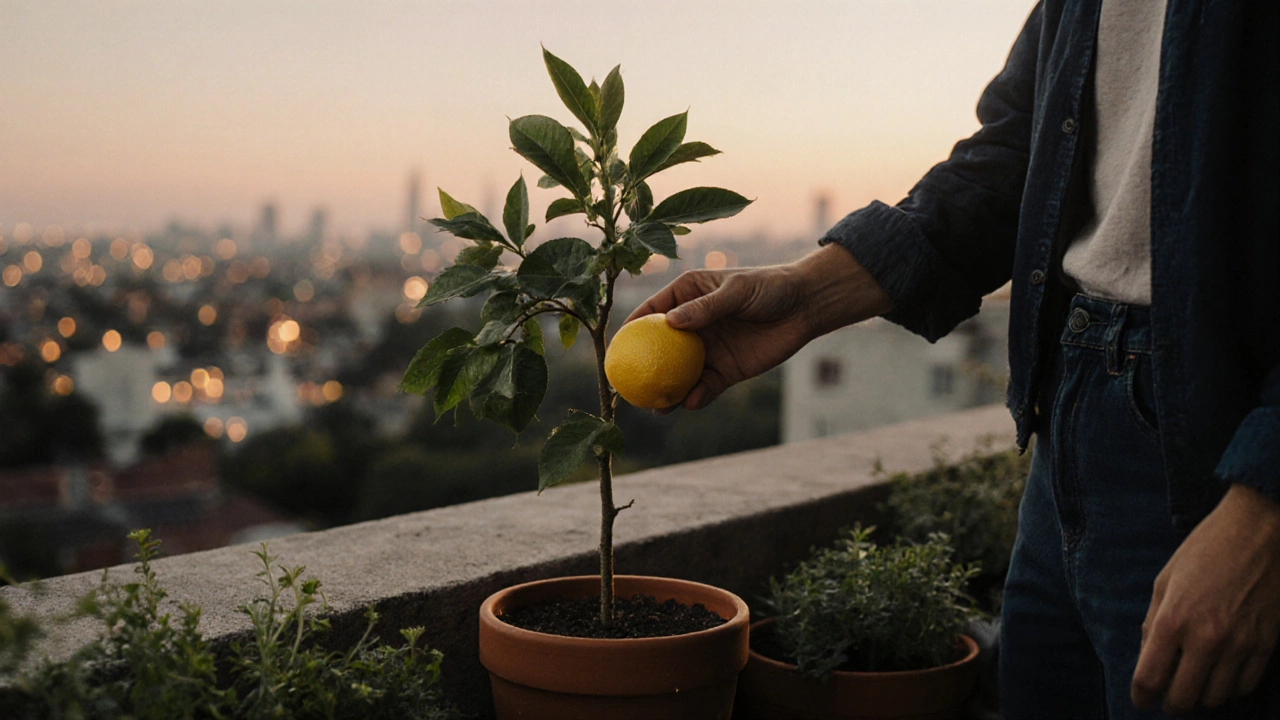
Alternatives If Lemons Don’t Work for You
Not every balcony gets enough sun. Not every person wants tart fruit. Here are other easy options:
- Dwarf lime trees (Key Lime or Kaffir Lime): Even more heat-tolerant than lemons. Great for sunny balconies. Kaffir lime leaves are used in cooking-add them to curries or teas.
- Dwarf orange trees (Satsuma or Calamondin): Calamondins are tiny, sour oranges that fruit year-round. They’re decorative and edible. Great for jams.
- Dwarf pomegranate: Surprisingly easy. Needs full sun. Produces small, sweet fruit. Looks like a shrub, not a tree. Very tough.
- Fig trees (if you’re willing to repot): Choose a dwarf variety like ‘Brown Turkey’. They fruit on new wood, so you can prune hard in winter. But they need repotting every 2-3 years.
These are all better than apples, peaches, or blueberries for beginners. Stick to citrus or pomegranate. They’re the only ones that truly play nice with pots and neglect.
Why This Matters for City Dwellers
Living in a city doesn’t mean giving up fresh food. A single dwarf lemon tree can give you more than 50 lemons a year. That’s 100+ tablespoons of juice. Enough to make homemade lemon curd, marinades, or just brighten your morning water.
It’s also cheaper than buying organic lemons at the supermarket. And it’s greener. No plastic packaging. No shipping emissions. No pesticides sprayed on orchards thousands of kilometers away.
Plus, there’s something powerful about growing your own food-even one lemon. It reminds you that nature doesn’t need perfection. It just needs a chance.
Final Tip: Don’t Overthink It
The easiest fruit tree to keep alive isn’t the most productive. It’s the one you don’t quit on. If you start with a lemon tree and forget to water it once, it won’t die. If you start with a peach tree and miss a pruning session, it might never fruit again.
Start small. Start simple. Start with a dwarf lemon. Put it in a pot. Give it sun. Water it when it’s dry. And wait. You’ll be surprised how much it gives back.
Can I grow a fruit tree on a north-facing balcony in Auckland?
North-facing balconies in the Southern Hemisphere get the least sun. Most fruit trees need 6+ hours of direct light. A dwarf lemon might survive, but it won’t fruit well. Stick to shade-tolerant herbs or ornamental plants instead. If you have a balcony that gets even 4 hours of sun, a dwarf lime or calamondin might work.
How long do dwarf fruit trees live in pots?
With proper care, dwarf citrus trees can live 15-25 years in pots. The key is repotting every 3-4 years to refresh soil and trim roots. If you never repot, the tree will slowly decline. But if you do it right, your lemon tree could outlast your apartment lease.
Do I need to pollinate dwarf lemon trees by hand?
No. Dwarf lemon trees are self-pollinating. Bees, wind, or even a gentle shake of the branches will do the job. You don’t need to touch a single flower. Just make sure the tree is healthy and getting enough sun-pollination happens naturally.
Are dwarf fruit trees safe for pets?
Dwarf lemon trees are not toxic to cats or dogs, but the peel and leaves can cause mild stomach upset if eaten in large amounts. Keep pets from chewing on branches. The fruit itself is safe. A few bites of lemon won’t hurt them, but don’t let them snack on rinds or leaves regularly.
Can I grow a fruit tree indoors near a window?
Indoors, most fruit trees won’t fruit. Even the sunniest windows don’t provide enough intensity or duration of light. A dwarf lemon might survive for a year indoors, but it will drop leaves, stop flowering, and eventually die. Move it outside in spring. Bring it in only during frost warnings.
If you’ve been waiting to start growing your own fruit, don’t wait for the perfect balcony. Start with a dwarf lemon. It’s the quiet hero of urban gardening. No drama. No fuss. Just fruit.
About
Gardener Support India is your go-to online destination for expert advice on gardening and horticultural services in India. Whether you're a beginner or an experienced gardener, our platform offers extensive resources, tips, and support tailored to Indian climates and plant species. Explore a wide range of guides on plant care, sustainable gardening practices, and innovative gardening solutions. Connect with local experts to enhance your gardening experience and maintain a flourishing garden. Our dedicated services aim to empower Indian gardeners with the knowledge and tools needed for a successful gardening journey.
Latest Posts

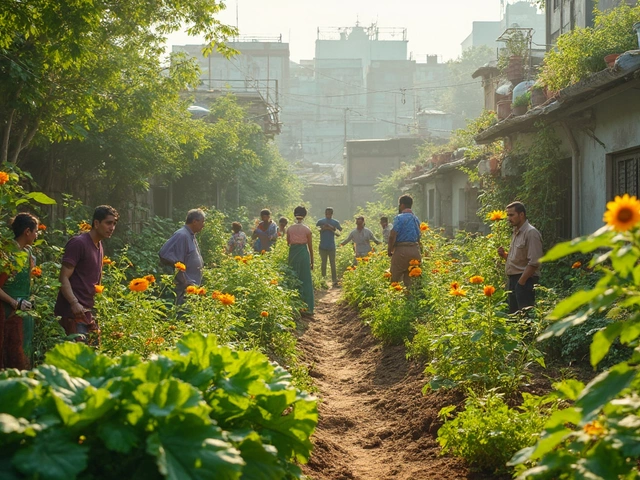
Can You Do Regenerative Agriculture Without Animals? Straight Talk for Gardeners
By Alden Thorne Apr 17, 2025

Compost vs Organic Compost: What Really Sets Them Apart?
By Alden Thorne Jun 4, 2025
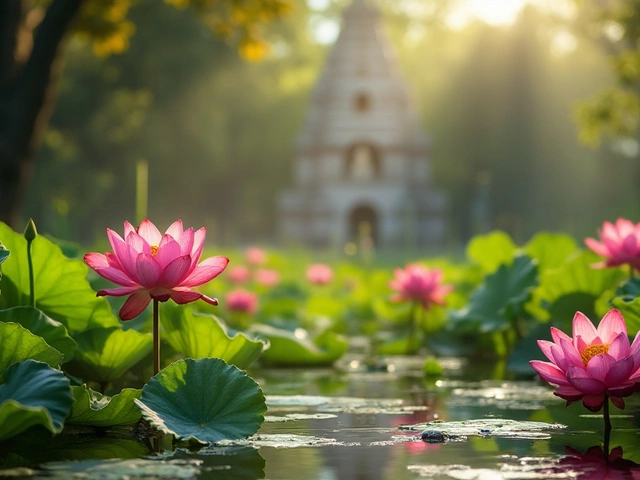
Exploring India's Sacred Lotus: A Symbol of Purity
By Alden Thorne Jan 19, 2025

Write a comment